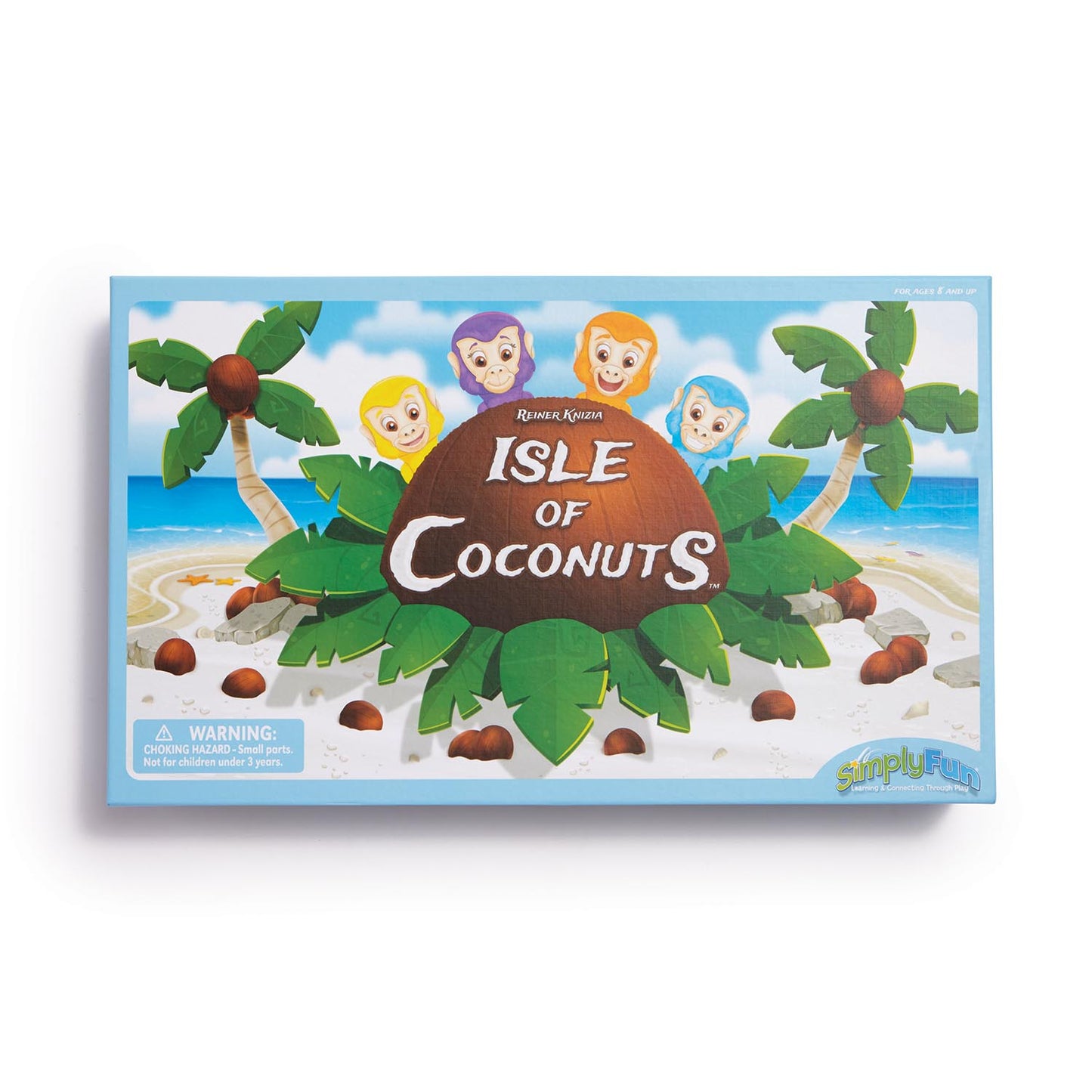
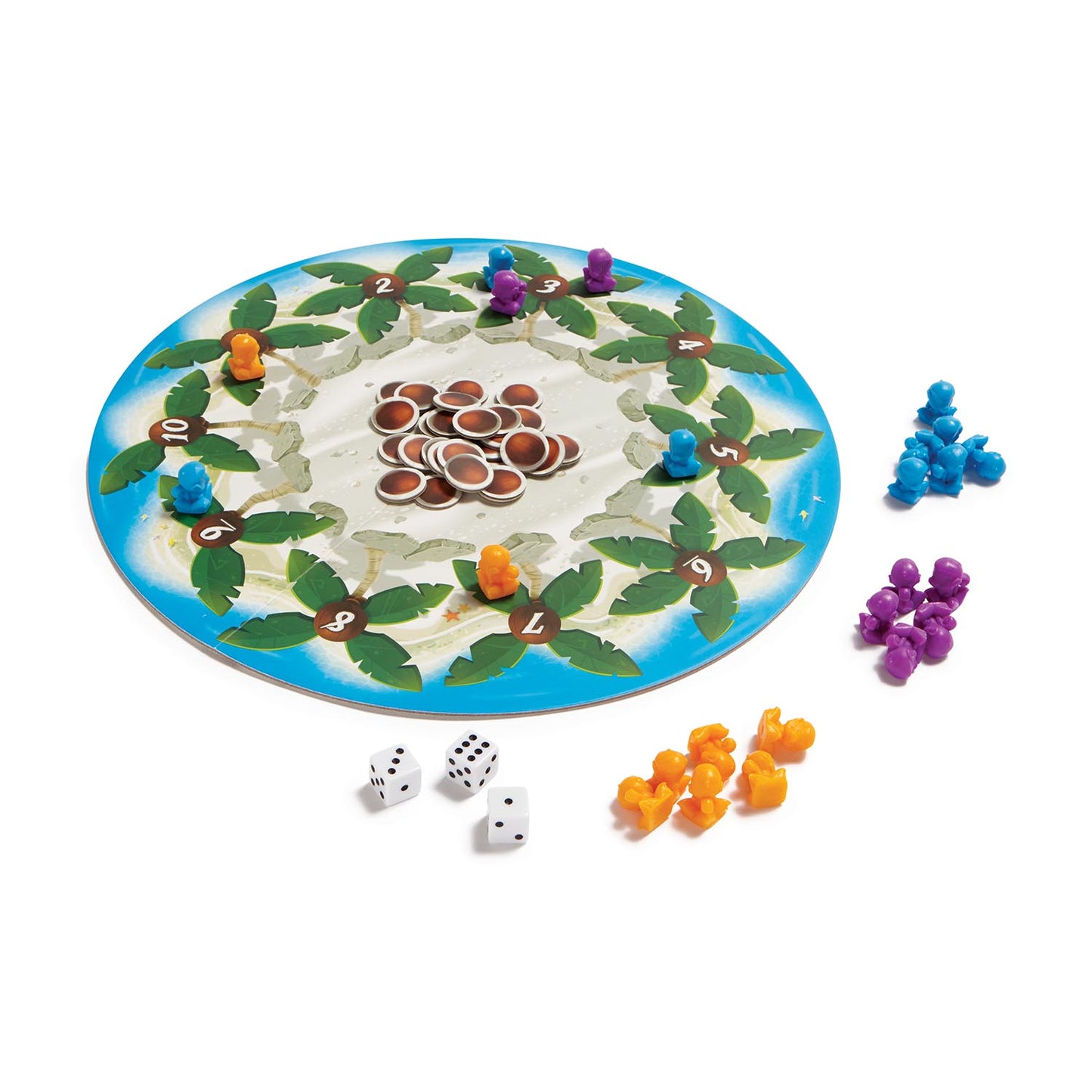
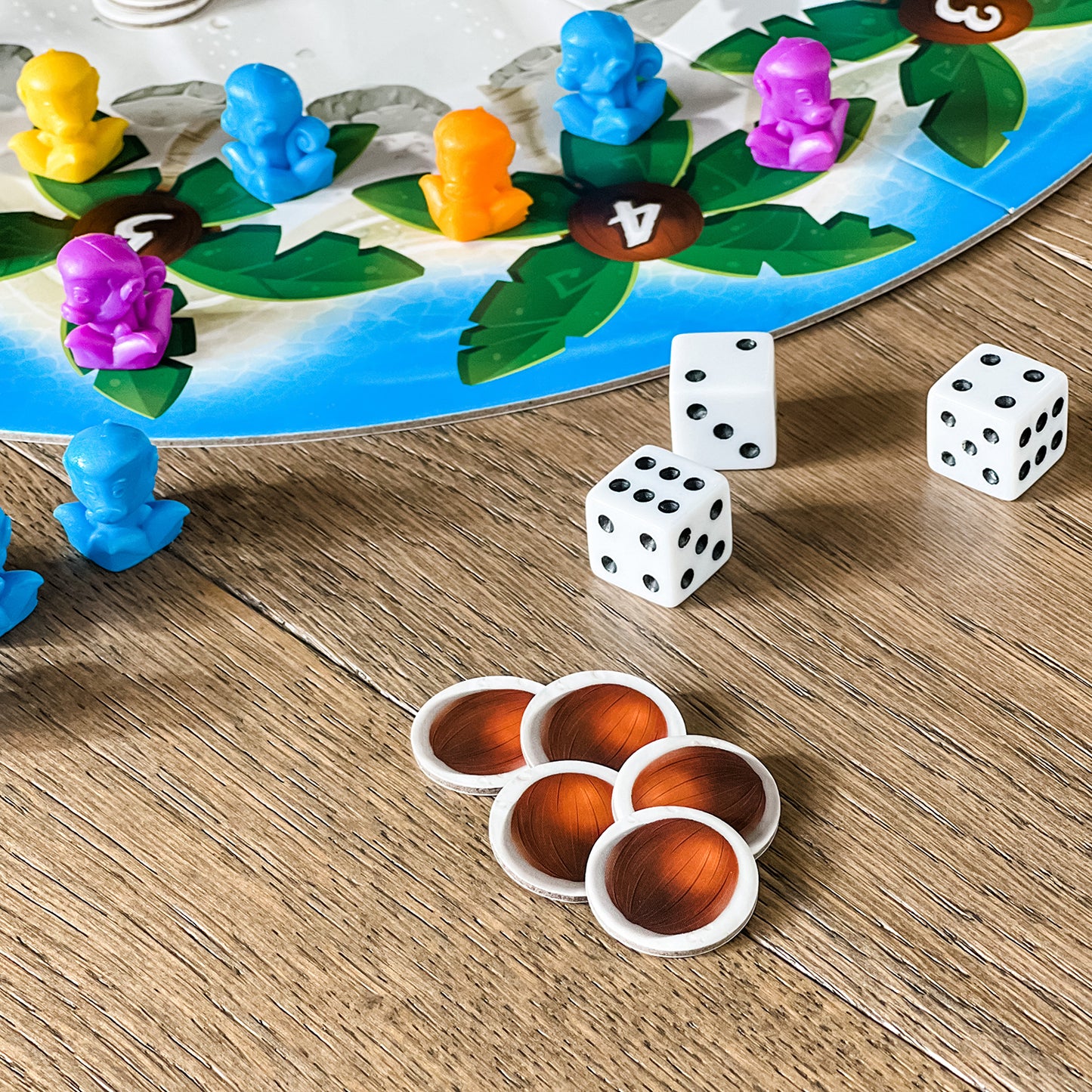
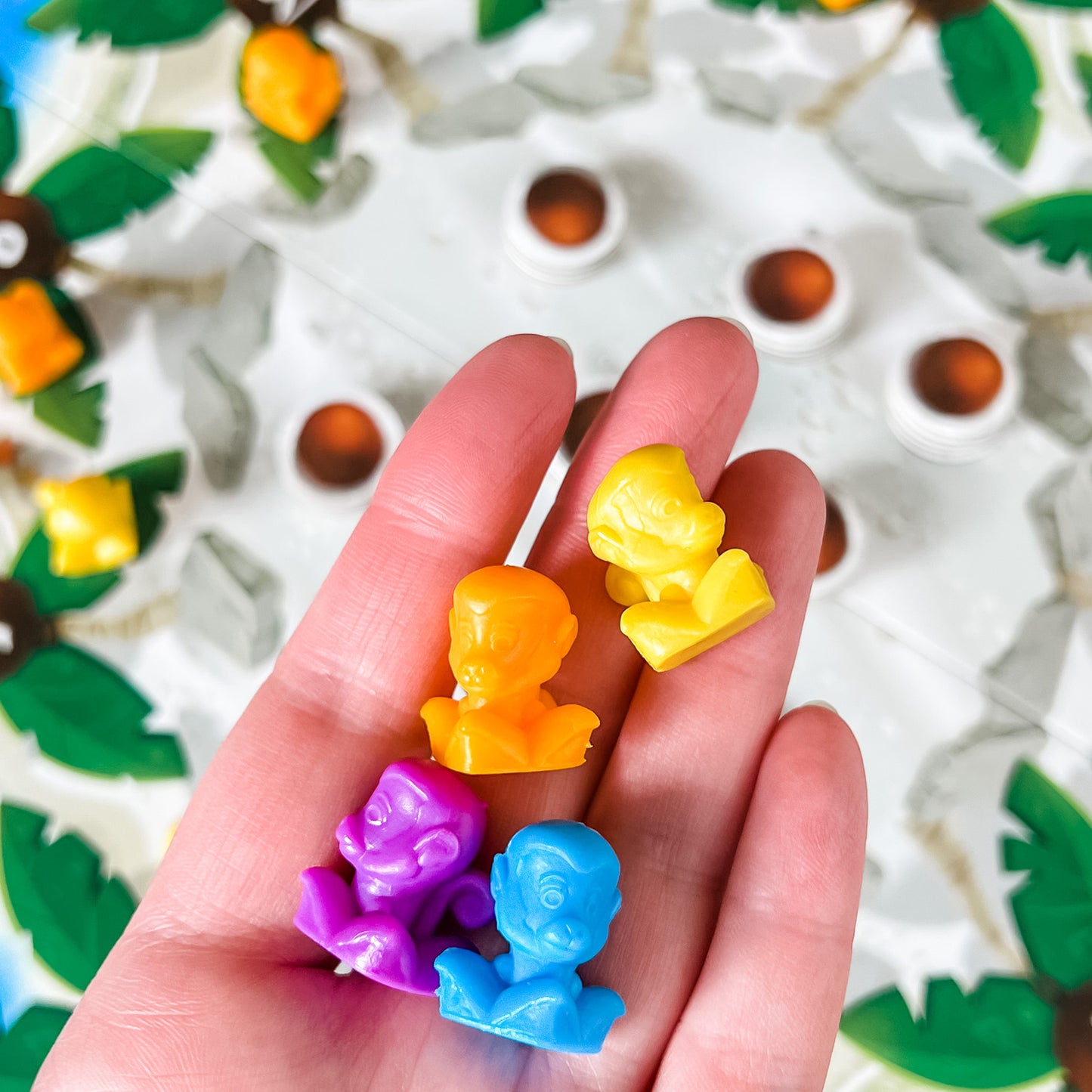
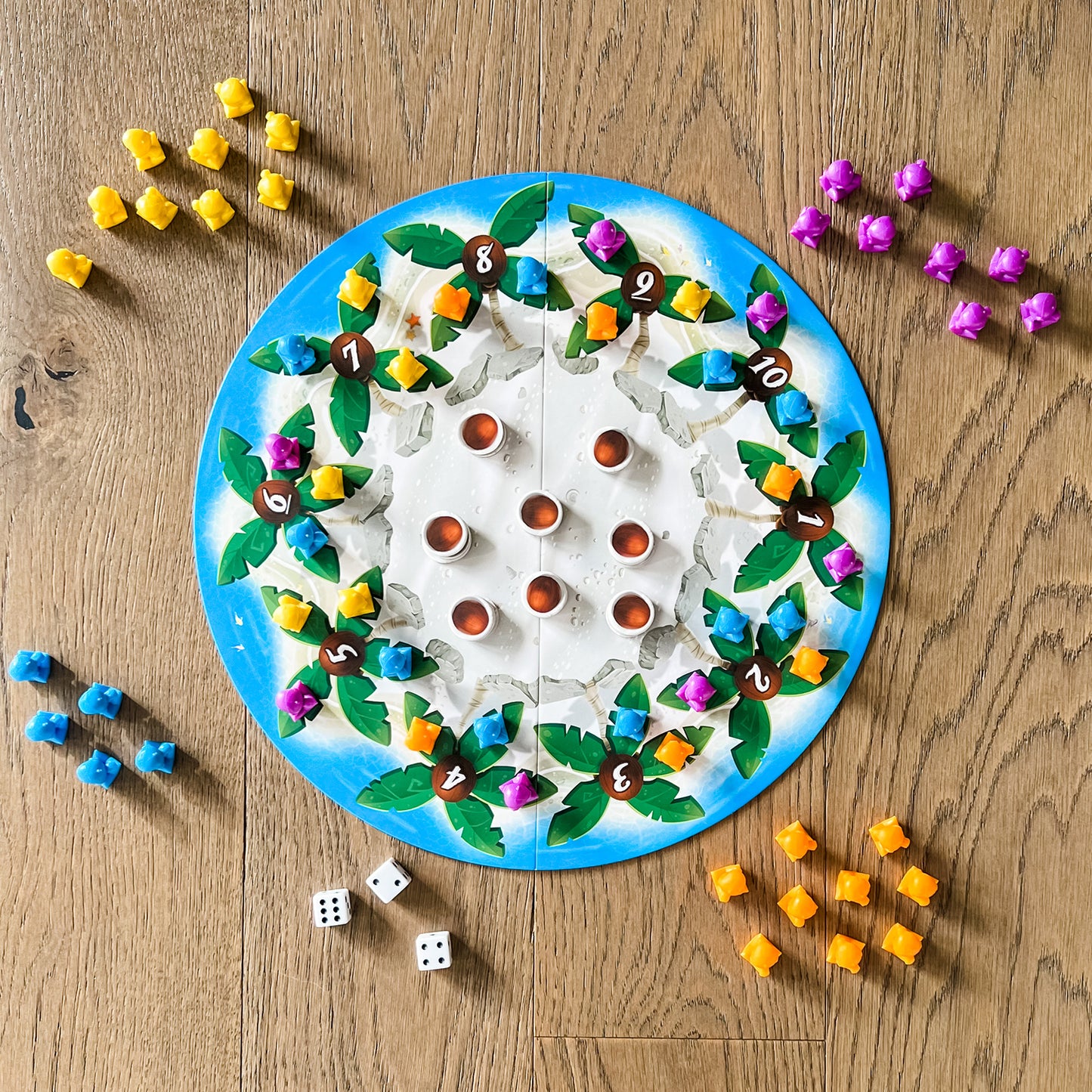

Collapsible content
Imagine yourself on a beautiful island with lush palm trees and teams of monkeys jumping from tree to tree competing for delicious coconuts. Now imagine you have to use quick addition skills and make wise choices to get those coconuts! You’ll find all of that when you play Simply Fun’s Isle of Coconuts.
Isle of Coconuts is fun for players ages 8 and up and can be played with 2 to 4 players.
In each Isle of Coconuts game box, you’ll find:
1 Isle Board with numbered coconut trees, and fronds where the monkeys will sit.
You’ll also find 60 monkey pawns, 15 each of blue, orange, yellow and purple monkeys
There are 45 coconut tokens to earn…
… and 3 six-sided dice that players will roll to determine where their monkey pawns go.
Set up the game by placing the Isle Board in the center of the table in reach of all players. Note that each palm tree is numbered, 1 to 10, and contains 3, 4 or 5 fronds around the number.
Have each player choose a team of 15 matching color Monkeys.
Count out 8 stacks of 5 coconut tokens each and place the stacks in the center of the board.
Place the dice near the Isle Board.
Put the remaining coconuts back in the game box and you’re ready to play!
To start the game, the first player starts their turn by rolling all three dice. They may use the dice one of three ways:
• the face value of each individual die,
• the sum of two dice and the face value of the third die, or
• the sum of all three dice
The way they use their dice will determine which number palm trees they put their monkeys on. When adding the dice, the highest sum possible is 10, players must use all the dice rolled on each turn, and they may only use each die once.
Generally, only one monkey can be placed on each frond. See the instruction booklet provided for the one exception to that rule.
As players place their monkeys, they must say the sum out loud so the other players know exactly which palm trees and dice combinations are being used.
Players should remember that the goal is to have the most monkeys on a tree once it’s filled while sharing the tree with other teams. Smart players will avoid trees where they are likely to have the least monkeys, tie other players for the most or be the only team on the tree.
If a player counts each die separately, the trees could look like this. If a player adds two dice and keeps one separate, the trees could look like this. All three dice together could result in this.
Refer to instruction booklet for special conditions and what to do if you don’t have enough monkeys to use all your dice.
At the end of a turn, the player looks to see if any palm trees have all of their fronds fully occupied.
If so, it’s time to count the teams on that tree to see who wins the coconuts. How may coconuts each team wins depends on how many monkeys they have or don’t have on a fully occupied tree. Refer to the instruction booklet for all the ways teams win coconuts.
Once a palm tree is filled and the coconuts are given out, all the monkeys on that tree are returned to their respective players. The tree is now empty and can be occupied again.
Play continues as players work to occupy trees with teams of monkeys and win coconuts. At the end of any turn, if the player’s team has won 10 coconuts, that player wins the game.
If there is a tie, the game continues until one player has more coconuts than all the other players. The player with the most coconuts wins!
Simply Fun’s Isle of Coconuts is more fun than a tree full of monkeys!


Core Standard*: None


Explore
What Does Child Do To Use Skill In The Game?
Players examine the board throughout the Isle of Coconuts game as they consider their next moves.
How Parents Can Assist Learning
Remind children to look at the board carefully during play, making sure to identify where the Monkeys are played and open frond spaces are available. This will discourage impulsive actions.
Learning Implications and Educator Support
Playing Isle of Coconuts helps children develop spatial reasoning skills, situational analysis, risk assessment and perspective changing. Educators can help social emotional development of patience and persistence by asking kids to explore the game board completely before making a move. This involves visual exploration and mental modeling of different scenarios.
Determine
What Does Child Do To Use Skill In The Game?
Players need to determine where they want to place Monkeys and how to combine their dice on each turn.
How Parents Can Assist Learning
Parents can explain various strategies, so that children can add to their thinking in making a decision. For example, "Would it be better to use each dice separately, or combine them together?" Or "What are your options?" Isle of Coconuts is good for teaching risk and reward analysis, as well as a combination of offensive and defensive strategies. Encourage children to consider a range of options such as pursuing high or low point trees, or avoiding trees that others are placing Monkeys on.
Learning Implications and Educator Support
Isle of Coconuts involves examining the board and creating mental models of the consequences of placing Monkeys, which in turn is based on the different dice combinations a player can choose. When first learning to play, players will think about consequences of the immediate move. As they become more proficient, children will think about multiple moves ahead in order to anticipate the moves of other players and set up trees to avoid or have the most Monkeys upon. Isle of Coconuts is also good for teaching risk and reward analysis. Educators can explain various strategies, so that children can add to their thinking in making a decision. For example, "Would it be better to use each dice separately, or combine them together?"
Compare
What Does Child Do To Use Skill In The Game?
As with determine, Isle of Coconuts requires a high level of comparing. Players will create mental models of the outcomes for different dice combinations and placement of Monkeys. Based on those models, they will compare outcomes to determine the best move.
How Parents Can Assist Learning
To help children evaluate different options, encourage them to "Wait. Look. Think." Ask children to describe aloud the potential reward and cost for playing Monkeys based on different dice combinations. Help them think about the impact of varying plays on their score as well as limiting the points of the other players.
Learning Implications and Educator Support
Making mental models of a space and movement in Isle of Coconuts is an advanced, complex cognitive skill that supports learning spatial relations, pattern recognition and creative problem solving. The game also helps children develop complex comparison skills as they consider options for placing Monkeys based on dice combinations to maximize scoring and avoid non-scoring moves. This also involves perspective changing as a child thinks about what other players may do in response to their placement of Monkeys. Further, Isle of Coconuts helps develop spatial reasoning, risk/reward analysis and directionality.
Remember
What Does Child Do To Use Skill In The Game?
Players may remember moves from prior games that were successful or not.
How Parents Can Assist Learning
Parents can remind children of similar situations from prior games and what happened when a player moved a particular piece.
Learning Implications and Educator Support
Educators can remind children of similar situations from prior games and what happened when a player moved a particular piece.
Predict
What Does Child Do To Use Skill In The Game?
Players think about where opponents are trying to capture a tree, or which trees they are trying to avoid.
How Parents Can Assist Learning
To help children predict, ask them to share different moves they are considering and what they think an opponent might move in response. Alternatively, ask them to think about what their opponent might move next. This may require playing non-competitively for the purpose of learning.
Learning Implications and Educator Support
Predicting involves skills like analysis, observation, empathy and interpretation. Also, children need to learn how to change perspective, imagining being their opponent, in order to have optimal predicting skills. Educators can prompt children to practice predicting by asking them to share what opportunities they see on the board, different moves they are considering and what they think an opponent might move on their next turn. This may require playing non-competitively for the purpose of learning.
Plan
What Does Child Do To Use Skill In The Game?
Isle of Coconuts involves a lot of planning as players think about how to play their 15 Monkeys while reacting to the moves of other players.
How Parents Can Assist Learning
To be successful in Isle of Coconuts requires thinking about consequences beyond a player's immediate move. This type of long-term, sequential thinking is important beyond the game for activities such as building forts, making art, successfully completing schoolwork on time and launching a new business from a lemonade stand to a company later on in life. Discuss options available on each turn to help children think about potential outcomes.
Learning Implications and Educator Support
Planning is an important skill for developing strategic thinking, persistence and reaching a goal. Encourage the children to discuss the goal throughout the game and how they might play their Monkeys to achieve the goal of scoring points while limiting others from scoring. Additionally, to be successful in Isle of Coconuts requires thinking about consequences beyond a player's immediate move. This type of long-term, sequential thinking is important beyond the game for activities such as building forts, making art, successfully completing schoolwork on time and launching a new business from a lemonade stand to a company later on in life.
Solve
What Does Child Do To Use Skill In The Game?
Players solve the game by responding appropriately to opponents' moves and scoring the most points with their Monkeys on the palm trees.
How Parents Can Assist Learning
Isle of Coconuts is good for trying different strategies to win. For example, is it a good idea to sacrifice a Monkey to prevent another player from scoring or would it be better to place a Monkey on an open tree? Discuss different strategies prior to starting the game and encourage the child to select one. Play the game and discuss. Then, play again with the child trying a different strategy. Discuss again and compare the advantages and disadvantages. Once children understand different strategies, they can shift and adapt strategies within a game.
Learning Implications and Educator Support
Isle of Coconuts is good for trying different strategies to win. For example, is it a good idea to sacrifice a Monkey to prevent another player from scoring or would it be better to place a Monkey on an open tree? Is it better to place Monkeys on high or low point value trees? Discuss different strategies prior to starting the game and encourage the child to select one. Play the game and discuss. Then, play again with the child trying a different strategy. Discuss again and compare the advantages and disadvantages. Once children understand different strategies, they can shift and adapt strategies within a game.
Review
What Does Child Do To Use Skill In The Game?
While not required in the game, players may review if encouraged.
How Parents Can Assist Learning
During or after the game, discuss moves and what worked and did not work as expected.
Learning Implications and Educator Support
During or after the game, discuss moves and what worked and did not work as expected. Teachers can watch as children play and ask children to describe their thinking when they make a particularly good move.
Demonstrate
What Does Child Do To Use Skill In The Game?
While not required in the game, players may demonstrate their thinking if encouraged.
How Parents Can Assist Learning
During or after the game, replay and discuss moves and what worked and did not work as expected. Thinking out loud is a good strategy for parents to use while playing the game. Children can be encouraged to do the same.
Learning Implications and Educator Support
During or after the game, replay and discuss moves and what worked and did not work as expected.
*Data compiled from CCSSI ELA Standards, WA Science Standards, and Washington Social Studies Standards


Cognitive
Suggestions for How to Modify Play Experience
Players need to weigh options for use of the numbers on the dice across different trees, as well as the number of Monkeys on each tree. Simple addition up to 10 is needed. Players also need to be able to add dice multiple ways to see options. For this reason, children with cognitive delays may benefit from playing the game in teams. Other players can then help the child see options and make good decisions.
To simplify the addition options, try playing with just two dice. This reduces the number of addition possibilities, making visualizing options easier.
Simplify the rules, so that the player with the most Monkeys on a tree gets two Coconuts and others on the tree get one Coconut. This simple "more" and "less" scoring will be easier for the child with cognitive challenges to understand.
Communication
Suggestions for How to Modify Play Experience
Players need to announce the totals of the dice they are playing. If children cannot verbally communicate, they can show totals with their fingers.
Encourage children to talk by asking why they chose to put their Monkey on specific trees.
Play with a partner to encourage talking to each other to make Monkey placement decisions.
Sensorimotor
Suggestions for How to Modify Play Experience
Players need to manipulate Monkeys, Coconuts, and dice. If fine motor skills are an issue, use a dice cup to make throwing easier. Have other players move Monkeys to the fronds and hand out the Coconuts that are won.
Players who cannot manipulate the pieces can play with a partner. This way one partner can move game parts, but both partners make Monkey placement decisions.
Social Emotional/Behavioral
Suggestions for How to Modify Play Experience
The game requires frustration tolerance, as opponents may place a Monkey in a desired spot or a specific roll of the dice may limit options. Talk about the player's feelings and reframe the situation to encourage positive thinking. For example, "I can see that move upset you. But, now you have more trees to choose from".
Players who are impulsive may not think about all of the options. Encourage players to manipulate the dice to see different options for totals. Also encourage them to think about what other players may be trying to do with their Monkeys.
Vision
Suggestions for How to Modify Play Experience
Children with low vision may have difficulty differentiating the yellow and orange Monkeys and purple and blue Monkeys, so seeing exactly how many of each color are on a tree may be difficult. The numbers on the tree may also be difficult to see, although they are fairly large and have a white against brown contrast.
If two players are playing, use contrasting colored Monkeys to make it easier for children with low vision to see where Monkeys are located.
Hearing
Suggestions for How to Modify Play Experience
Hearing concerns should not be an issue, as communication is not needed. Players may use sign language or indicate play explanations with fingers.
*Data compiled from CCSSI ELA Standards, WA Science Standards, and Washington Social Studies Standards


Autism Strengths & Interests
Short Summary of Strengths & Interests
- Can add numbers to total up to 10 in numerous ways.
- Has good spatial reasoning.
- Can predict and respond to moves of other players.
Is good at matching visual items
Is This Game Appropriate? Yes
Description
Players need to match numbers on dice or totals of numbers on the dice to the written numbers on the palm trees.
Has a good memory for words, phrases and dialouge
This game is not appropriate
Has a good memory for pictures, numbers and patterns
This game is not appropriate
Likes to put things in order or a sequence
This game is not appropriate
Learns through visualizing or "replaying" actions in their mind
Is This Game Appropriate? Yes
Description
Players need to accumulate Monkeys on the palm trees to earn coconuts. Players need to understand the scoring and placement rules to know which trees to place Monkeys on and which trees to avoid.
Likes activities with rules, such as math and phonics
This game is not appropriate
Is very concrete and literal
This game is not appropriate
Learns in small "chunks" (for example, phone numbers are 3 chunks of number xxx-xxx-xxxx that are combined together)
Is This Game Appropriate? Yes
Description
Some aspects of Isle of Coconuts are concrete.Playing their Monkeys on numbered trees according to dice totals is straight forward and concrete.The rules for scoring, however, are more abstract and require memory of the rules.
Is good at nonverbal reasoning and logic
This game is not appropriate
Likes spatial problem solving
Is This Game Appropriate? Yes
Description
Understanding the rules for scoring enables players to use prediction and reasoning to determine the best trees to place Monkeys on to win coconuts.
Can read well with good vocabulary, though may not fully comprehend content
Is This Game Appropriate? Yes
Description
Each of the palm trees has different numbers of fronds.Players need to understand how to use their Monkey on each of the fronds, and when they can place two Monkeys on the same frond.
Likes to use and has good fine motor skill
Is This Game Appropriate? Yes
Description
Many of the Activity Cards require the player whose turn it is to read instructions to or ask questions of the other players.
Likes established routines or set ways of doing things
Is This Game Appropriate? Yes
Description
Description VERBIAGE GOES HERE
Likes manipulating, constructing or building things
This game is not appropriate
Likes to use and has good musical abilities
This game is not appropriate
Likes to use and has good drawing skills
This game is not appropriate
Autism Special Considerations
Appears to ignore other's communication and/or has difficulty giving eye contact to a communication partner
Is This Game Appropriate for Child with Characteristic? Yes
Can Child with Characteristic Play Game w/o Modification? Yes
Strategies for Developing Compensatory Skills:
Eye contact is not needed for Isle of Coconuts; however, communication about moves is encouraged.
Has difficulty understanding complex verbal directions
Is This Game Appropriate for Child with Characteristic? No
Can Child with Characteristic Play Game w/o Modification? No
Strategies for Developing Compensatory Skills:
The rules for scoring in this game are complex. Players need to understand these rules in order to make decisions about what moves to make.
Uses vocabulary inaccurately or demonstrates echolalia (repeating another's speech)
Is This Game Appropriate for Child with Characteristic? Yes
Can Child with Characteristic Play Game w/o Modification? Yes
Strategies for Developing Compensatory Skills:
Echolalia should not interfere with the game, as long as the child is not too far off topic. Try to point out and talk about what is happening on the board.This will provide a focus for conversation.
Gets stuck repeating a verbal topic or physical actions and/or has difficulty attending to others' actions or topic.
Is This Game Appropriate for Child with Characteristic? Yes
Can Child with Characteristic Play Game w/o Modification? No
Strategies for Developing Compensatory Skills:
If the child has repetitive actions unrelated to the game, give the child a "fidget toy" or provide a desired action or toy between toys. Also provide opportunity for everyone to move after a round of turns.
Has difficulty producing speech/communication
Is This Game Appropriate for Child with Characteristic? Yes
Can Child with Characteristic Play Game w/o Modification? Yes
Strategies for Developing Compensatory Skills:
Communication is not necessary to play Isle of Coconuts, but discussion of moves is encouraged.
Has difficulty sequencing multi-step actions and/or doing complex abstract tasks
Is This Game Appropriate for Child with Characteristic? No
Can Child with Characteristic Play Game w/o Modification? No
Strategies for Developing Compensatory Skills:
Each turn in Isle of Coconuts involves choosing where to put a player's Monkeys based on the roll of dice. This is a simple process, but players need to think strategically about where to place their Monkeys based on where other players' Monkey are located. This involves understanding the rather abstract rules for scoring.
Demonstrates difficulty initiating and maintaining social interactions
Is This Game Appropriate for Child with Characteristic? Yes
Can Child with Characteristic Play Game w/o Modification? Yes
Strategies for Developing Compensatory Skills:
Social interactions are not needed, but can be encouraged by discussing the effects of each player's moves.
Acts out or demonstrates avoidance behaviors when frustrated, overwhelmed, or needs more sensory input.
Is This Game Appropriate for Child with Characteristic? Yes
Can Child with Characteristic Play Game w/o Modification? No
Strategies for Developing Compensatory Skills:
If avoidance behaviors occur, interject additional game play. After each round of play let players take turns thinking of movements or actions all players need to do together. "Everyone turn in a circle three times!"
Has short attention span for non-preferred activities
Is This Game Appropriate for Child with Characteristic? No
Can Child with Characteristic Play Game w/o Modification? No
Strategies for Developing Compensatory Skills:
If is not interested in the game, use preferred activities as reinforcers between turns. For example, "After my turn we are going to all do an action that Adam likes." Then it will be Sara's turn in the game.
Needs sameness or consistent routines and/or has difficulty with transitions from one activity to another
Is This Game Appropriate for Child with Characteristic? No
Can Child with Characteristic Play Game w/o Modification? No
Strategies for Developing Compensatory Skills:
Although the turns involve the same actions each time, players need to consider different variables in each turn depending on what other players have done. This lack of predictability may make it difficult for some children to enjoy this game.
Has difficulty understanding others' feelings, intentions, and the reasons for others' actions.
Is This Game Appropriate for Child with Characteristic? Yes
Can Child with Characteristic Play Game w/o Modification? No
Strategies for Developing Compensatory Skills:
Players need to anticipate what other players may intend to do with their Monkeys on the palm trees. If the child can understand the scoring rules, they may be able to play the game. Some frustration may result when players place Monkeys on trees where they want their Monkeys to go. Take advantage of the opportunity to label these feelings so the child will learn these terms.
*Data compiled from CCSSI ELA Standards, WA Science Standards, and Washington Social Studies Standards


Extra Ways to Play the Game
Allow players to use addition, subtraction, multiplication, and/or division with the three dice to come up with totals that match the numbers on their desired palm trees.
Materials Needed
No additional materials are needed.
Developmental Benefits
This modification to Isle of Coconuts elevates the game into a higher level math game. Players still need to make strategic decisions, but they have more options for how to end up on desired trees.
Extra Ways to Play the Game
If you roll 3 of a kind of 1, 2, or 3, you can take the total number (3, 6, 9) and move your Monkey to a frond on the 3, 6, or 9 tree, OR remove another player's Monkey from a frond on a tree.
Materials Needed
No additional materials are needed.
Developmental Benefits
This modification gives players an opportunity to use an additional reasoning and strategy. Players can weigh the risk and reward for removing another player's Monkey versus adding another of their own Monkeys.
*Data compiled from CCSSI ELA Standards, WA Science Standards, and Washington Social Studies Standards
- Choosing a selection results in a full page refresh.
- Opens in a new window.







